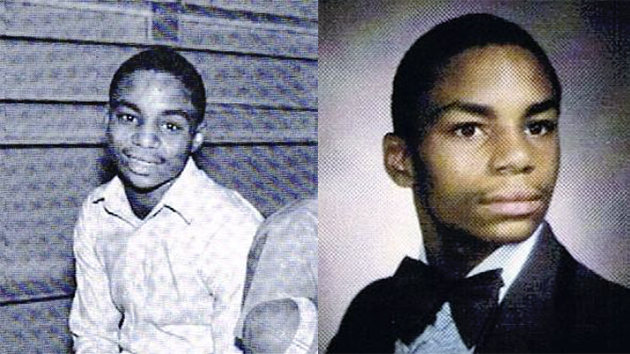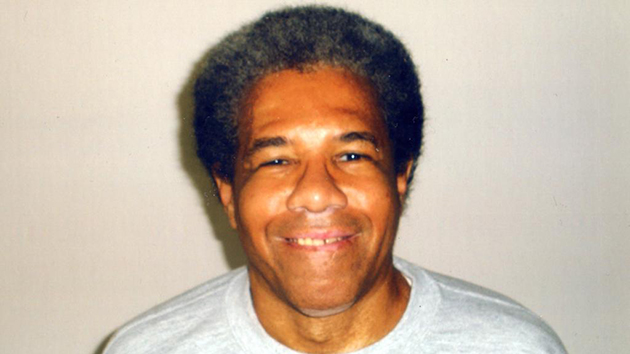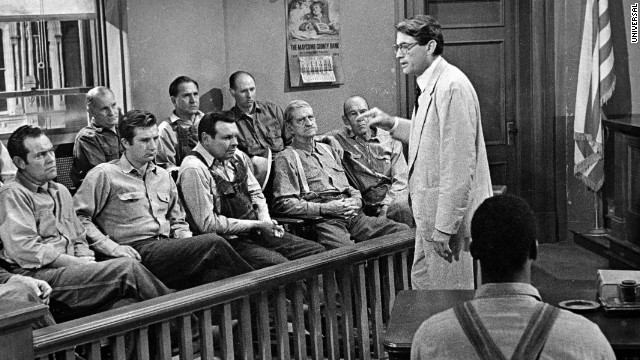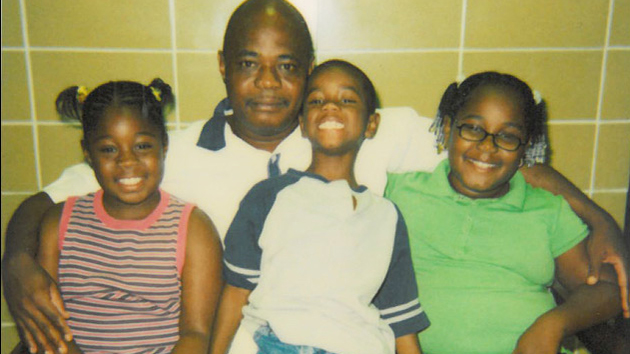
Terry Williams in an undated photo (left) and in high school
You could hardly open a Pennsylvania newspaper in 2012 without running into a story about the prosecution of sexual predators or their enablers. The case of Jerry Sandusky, the Penn State football coach convicted of abusing 10 boys, was all over the headlines. Two Philadelphia grand juries, in 2003 and 2011, had documented a massive cover-up of sexual abuse by the Catholic Church that would end up with two priests and a monsignor going to prison—the latter was the first senior church official in the United States convicted of endangering children by covering up abuses by priests under his supervision.
In July 2012, after yet another priest was arrested, Philadelphia District Attorney Seth Williams lauded the alleged victim for speaking out after years of silence: “As we have learned,” Williams said, “it is extremely difficult for sexual abuse victims to admit that the assault happened, and then to actually report the abuse to authorities can be even harder for them.”
The grand juries had made similar points. The most recent version of Pennsylvania’s statutes of limitation, noted the 2003 grand jury report, required prosecutors to initiate sexual-abuse cases by the child victim’s 30th birthday, but “the experts have told us that this statute is still too short. We ourselves have seen that many victims do not come forward until deep into their thirties, forties and even later.”
The 2011 grand jury was even more forceful, noting that most victims don’t come forward “for many years, or even decades.” Seven of Sandusky’s victims took a combined 73 years to report their ordeals. The Pennsylvania legislature responded by passing a law allowing the use of experts at trial to help juries understand how sexual violence affects its victims, and how they typically behave.
But these sex abuse scandals weren’t the only legal dramas capturing the public’s attention that year. In September 2012, a man named Terry Williams was in the final throes of an effort to survive a death sentence imposed on him for a crime he’d committed a few months after his 18th birthday. The Philadelphia DA’s office was working overtime to ensure the commonwealth’s first involuntary execution in half a century. But there was something about the DA’s enthusiasm that seemed out of place: Terry Williams had been convicted, in separate trials, of murdering two much older men who had sexually abused him as a minor.
In the first case, a jury convicted Williams of third-degree murder after it was made aware of the victim’s sexual relationship with his killer. In the second, the jurors never heard evidence of the victim’s proclivity for sleeping with teenage boys. They convicted Williams of first-degree murder and sentenced him to die.
After reading a summary of the crime provided by the DA’s office, some might conclude that Williams was nothing but a violent psychopath who got what he deserved.
Terrance Williams robbed and murdered two middle-aged gay men. He stabbed Herbert Hamilton more than 20 times and then beat him with a baseball bat. Months later, he lured Amos Norwood to a cemetery where Williams and a friend brutally bludgeoned him to death so they could steal his belongings and take a joy ride to Atlantic City in his car. Williams also committed other robberies, including one in which he broke into the home of an elderly woman on Christmas Eve with a rifle and threatened to blow her “f—ing head off.”
But this account leaves out some salient facts. Namely, that both men were having sex with Williams, and that Norwood had been doing so since Williams was just 13. The robberies the DA describes followed years of sexual victimization, as the Third Circuit Court of Appeals summarized in 2011:
When Williams was very young, perhaps around the age of six, he was sodomized by a neighbor boy five years his senior. In his early teens, he was repeatedly molested by a teacher. At thirteen, Williams met and began a relationship with Norwood. Norwood was cruel and physically abusive at times; he once allegedly beat Williams with a belt. When Williams was approximately fifteen, he was attacked by an older male while staying in a boys’ home. The assailant held a weapon to Williams ‘ neck and forced him to perform fellatio.
The DA’s office has contested each of these facts, claiming that “not one of the purported incidents was contemporaneously reported to medical or law enforcement officials.” Even today, a spokesman for the DA characterizes the murders as “hate crimes,” adding that “it is well past time for some skepticism about [Williams’] self-serving claims, and some sympathy for the trail of victims he has left in his wake.”
Yet this view ignores evidence that was present in the district attorney’s own files even before Williams stood trial in 1986.
When a condemned person seeks a new sentencing, the appeals court is often confronted with evidence that should have been presented at the original sentencing, but wasn’t. The court’s task is then to determine whether that evidence would have influenced the outcome. In the months leading up to Williams’ execution date, five of the jurors who had condemned him wrote affidavits declaring that they indeed would have voted differently had they known of his sexual relationship with the victim.
In addition, dozens of former prosecutors signed a letter to then-Gov. Tom Corbett, urging him to commute Williams’ death sentence, and more than 350,000 people signed an online petition seeking clemency for Williams. After a deputy district attorney suggested in court that Williams’ crimes were the result of “gay-prostitute rage,” coalitions of sexual-assault survivors from 16 states signed a letter condemning the Philly DA for the “ill-informed stereotypes” his office was perpetuating. “By any definition—legal, ethical, psychological—a sexual encounter between a 13-year-old child and a 51-year-old man is rape,” the letter stated. “To call this ‘prostitution’ and imply agency and willing participation on the part of a 13-year-old boy is unacceptable.” But none of these things persuaded a court to vacate Williams’ death sentence.
A few weeks before the execution date, Shawn Nolan, one of Williams’ federal defenders, appeared at a clemency hearing before the Pennsylvania Board of Pardons. Yes, Williams had lost all of his appeals, Nolan acknowledged, but “is that a reason to kill this battered, sexually abused, barely 18-year-old kid?” Just the previous week, he reminded the board, one of the prosecutors had been asked, “Why are you fighting so hard to execute this man? After 50 years of no executions like that, why this man?”
Pennsylvania’s attorney general, one of the presiding board members, asked whether Nolan was “seriously contending” that the DA’s office was “pursuing this merely because they won the case?”
“Yes,” Nolan replied.
Minutes later, an assistant district attorney representing the DA’s office told the board that it was “no secret that the reason we’re here today, and the reasons these proceedings are unfamiliar, is that this is the only contested Pennsylvania death penalty case that has not been reversed by either state or federal court in many years.” Indeed, hundreds of death sentences had been overturned for reasons ranging from the hiding of evidence to the illegal disqualification of black jurors to just plain incompetent lawyering. But this case had survived the scrutiny of the courts.
As the day approached, the signatures on the clemency petition continued to pile up, as did the mail. Letters poured into the governor’s office from retired judges and child advocates, law professors, mental health professionals, and clergy. Editorials against the execution appeared in newspapers across the state. Even the victim’s widow wrote a letter stating that she had forgiven Williams and did not want to see his sentence carried out. Yet the prosecution pushed on, leaving the question raised at the clemency hearing still hanging. Was it possible that Philadelphia’s district attorney wanted to execute Terry Williams simply because he could?
most crime stories are best told chronologically. But the pivotal moment in Terry Williams’ legal saga came 28 years after the crime, just days before his scheduled execution. The setting: The courtroom of Judge Teresa Sarmina, a former prosecutor assigned to oversee last-minute appeals in the case.
Sarmina (who by coincidence had presided over the landmark Catholic Church sex abuse trial only months before) took what she deemed “extraordinary measures” to vet the fairness of Williams’ death verdict. She ordered Andrea Foulkes—Williams’ prosecutor, by then a lawyer with the US Attorney’s Office in Philadelphia—to testify about her handling of Williams’ two trials. Sarmina also ordered that the police department’s homicide files and the district attorney’s trial files be brought to her courtroom for examination. She wanted to be confident, she said, that the verdict “was what the word ‘verdict’ means: To speak the truth.”
The search for the truth in a criminal case always begins with the prosecution. A homicide trial in particular takes shape in the DA’s office long before a jury is selected—and sometimes before a suspect is even arrested. Investigations are launched, statements taken, reports completed, and by law, any information that might conceivably be helpful to the accused must be shared with the defense. This is a constitutional obligation, and yet the law books are replete with cases in which such exculpatory evidence is never passed along.
Judge Sarmina wrote in the Williams case that the paperwork involving the victim, Amos Norwood, had been “sanitized.” This was a polite way of putting it. The prosecution had omitted portions of two witness statements before turning them over, thereby eliminating the evidence of Norwood’s sexual proclivities.
Although the most sordid details weren’t known at the time, Norwood, 56, was known to have engaged in very suspicious behavior with young boys. Before it was redacted by the prosecutors, one police report had indicated that Norwood disappeared overnight with a teenage boy and, upon returning home the next day, told his wife he’d been kidnapped. The other censored document recounted that a mother from Norwood’s church had complained of his sexual advances toward her underage son.
Prosecutor Foulkes’ handwritten notes—which were also withheld from the defense, and which made reference to a now-defunct police unit nicknamed the “faggot squad”—indicated that she was aware of the victim’s appetites. Foulkes later conceded to Sarmina that she suspected a “sexual connection” between Williams and Norwood: “Of course it occurred to me.” But she didn’t bother sharing this with the defense.
To understand why, it’s necessary to look at the first murder Williams committed, when he was 17. The victim was 51-year-old Herbert Hamilton, who had a history of paying for sex with teenage boys. Hamilton had been in such a relationship with Williams, who ultimately beat and stabbed him repeatedly before dousing his body with kerosene in a failed attempt to dispose of it—”I loved you” was scrawled in toothpaste on Hamilton’s bathroom mirror. After hearing the evidence, the jury acquitted Williams of first-degree murder and instead found him guilty of third-degree murder, which carried a far lesser penalty.
Foulkes had sought death in that case, too, but she professed to have been satisfied with the outcome: “I didn’t care what the verdict was as long as the jury considered all the evidence,” she later testified. Judge Sarmina didn’t believe her: “The third degree verdict in the Hamilton case,” she wrote, “colored Ms. Foulkes’ decisions when she prosecuted [Williams] for the murder of Amos Norwood.” Indeed, less than a year after the Hamilton trial, Foulkes told the Norwood jury that Williams had killed him “for no other reason but that a kind man offered him a ride home.” She continued:
“He has taken two lives, two innocent lives of persons who were older and perhaps unable certainly to defend themselves against the violence that he inflicted upon them. He thought of no one but himself, and he had no reason to commit these crimes.”
That jury, none the wiser, sentenced Williams to death.
Sarmina ultimately stayed Williams’ execution and granted him a new sentencing hearing, at which a jury would be able to hear the suppressed evidence. Far from being chastened, the Philadelphia DA’s office dug in its heels. There were other courts to turn to. Higher courts.
The Supreme Court of Pennsylvania was no friend to capital defendants. In the five years before the Williams case came onto its docket, the court, led by Chief Justice Ronald Castille, had ruled in favor of the death penalty 90 percent of the time. This wasn’t too surprising, given that Castille had been elected to his judgeship in 1993 as the law-and-order alternative to a candidate he labeled soft on crime. (He became chief justice in 2008.) Before joining the court, he had been Philadelphia’s district attorney.
“Castille and his prosecutors sent 45 people to death row during their tenure, accounting for more than a quarter of the state’s death row population,” the Pittsburgh Post-Gazette noted in 1993. “Castille wears the statistic as a badge. And he is running for the high court as if it were exclusively the state’s chief criminal court rather than a forum for a broad range of legal issues.” Castille was pretty clear about where he stood: “You ask people to vote for you, they want to know where you stand on the death penalty,” he told the Legal Intelligencer, a law journal. “I can certainly say I sent 45 people to death row as District Attorney of Philadelphia. They sort of get the hint.”
One of the 45 was Terry Williams. In fact, it was Castille who, in a handwritten note to the chief of his homicide unit, had approved Williams’ capital prosecution in 1986. You could make a strong argument that a judge in his position should recuse himself from the appeals process, but Castille had a fraught relationship with the Federal Community Defender Office, a group of lawyers who represent numerous death row inmates, including Williams. Castille claimed that federal lawyers had no business appearing in state courts. He complained bitterly over the years about their “prolix and abusive pleadings” and about all the resources they dedicated to defending death row inmates—”something one would expect in major litigation involving large law firms.”
The defenders, for their part, routinely filed motions arguing that Castille had no business ruling on the appeals of prisoners whose prosecutions he had approved—particularly not in a case in which his office was found to have suppressed evidence helpful to the defense. But as chief justice, Castille had the last word. He denied all such motions, and accused the federal defenders of writing “scurrilously,” making “scandalous misrepresentations,” and having a “perverse worldview.”
Thus it stood on October 1, 2012, when Williams’ attorneys filed a motion asking Castille to recuse himself from their client’s appeal. The chief justice denied it that very day, along with a second request—to let the full Pennsylvania Supreme Court rule on the appropriateness of his involvement.
You might assume that a prosecutor who hides key evidence, especially in a death penalty case, would be subject to discipline—if not criminal charges. But courts are as loath to punish a prosecutor as they are to assist a murderer. The Pennsylvania Supreme Court’s ruling in Commonwealth v. Terrance Williams, which was released in December 2014, contained not so much as a footnote scolding Foulkes for what Judge Sarmina politely termed “gamesmanship.” Instead, the court excoriated the defendant for failing to make an issue of his sexual abuse at the hands of the older man. These were, in fact, the prosecution’s own arguments, coming from the same DA’s office that had recently acknowledged how excruciatingly difficult it was for sexual-abuse victims to go public. Of Terry Williams, the court wrote:
He could have argued Norwood’s homosexual proclivities developed into sexual abuse, leading to rage and ultimate murder of Norwood… However, [Williams] chose not to do so. Instead, [he] perjured himself at trial, testifying he did not know the victim, had never seen him before, took no part in the murder, and had no reason to be angry with him or wish to harm him.
Castille, who was on his way out due to a mandatory age retirement, voted with the majority but couldn’t resist taking a final salvo at the federal defenders’ “blatantly frivolous” litigation. In a concurring opinion, he warned the lower courts not to let themselves be turned into circuses with the defenders as “ringmasters.” And he upbraided Sarmina for letting Williams’ lawyers scour the government’s files. The information they revealed, he wrote, had smeared Norwood’s character.
In any case, the high court reinstated Williams’ death sentence and ordered that the court record be sent to the outgoing Gov. Corbett, who just before leaving office set the execution date for March 4, 2015. Following it through would fall to his successor, Gov. Tom Wolf.
To understand why Williams might have denied knowing Norwood, it helps to go back to the first day of jury selection in his capital trial, when Williams announced to the court that he’d only met his lawyer the day before and wanted a new one. The defense lawyer, assigned to Williams’ case by the Philadelphia court system, acknowledged that this was true. Williams, he explained, was incarcerated at a prison far from the city, so he’d relied on his associate for “a lot of the detail work.” When the judge asked which prison Williams was housed in, the lawyer had to turn to his client to ask. The judge nevertheless deemed the attorney “very adequate” and denied Williams’ request for a replacement.
Whether the attorney’s preparation was truly adequate—a federal judge would later deem his performance “constitutionally deficient”—one thing was clear: There was no trust between the client and his lawyer. Did the prosecutors truly expect a teenager facing a possible death sentence to have a frank discussion about his sexual victimization with a court-appointed lawyer he’d just met?
As the first Pennsylvania execution of the 21st century loomed, Gov. Wolf made a historic announcement: He was granting a reprieve to Terry Williams and any other inmate facing execution until a state task force completed a study of the death penalty and officials had a chance to act on its recommendations. In a five-page memo, Wolf listed race discrimination, bad lawyering, high costs, and the threat of executing an innocent man among the reasons for his decision.
The announcement was no great surprise, given that Wolf and all of his Democratic primary rivals supported a moratorium on executions—and that Wolf had handily defeated a pro-death penalty incumbent in the general election. Even the new chief justice of the Pennsylvania Supreme Court had declared the system in “disrepair,” and had written extensively on its failings. But death penalty supporters were furious. Seth Williams was among the first to lash out. The people who would be the “most grateful,” the DA announced, “are the guiltiest, cruelest, most vicious killers on death row.” As for Terry Williams, the DA was “weary of this murderer’s effort to portray himself as a victim.”
He failed to mention, of course, the censored police reports, or the Board of Pardons’ 3-2 vote in Williams’ favor (a unanimous vote is required for clemency). The DA simply reiterated that the prisoner was guilty of heinous crimes. “The governor’s action today was an injustice to the citizens of this state,” he concluded. “And to victims of crime.”
Several weeks later, during a televised debate, Seth Williams further articulated his case: Terry Williams, he said, “brutally beat to death two gay men because he was extorting them.” This was a bewildering claim from the head of an office that prosecuted hundreds of sexual-abuse cases a year: You could spend decades digging through the Philadelphia court dockets and be hard-pressed to find a case in which teenage boys hired to service middle-aged men were charged with extortion.
But the DA didn’t stop there. Explaining that he agreed the death penalty was appropriate only in the “worst of the worst of the worst” cases, he attempted to describe how the systemic problems the governor had described did not apply to Williams.
“Every appellate court has said issues of racism, yes, they exist in the criminal justice system, but not in this case. Cases of people not being given the attorneys that are appropriate, that exists, but not in this case…”
Each of these statements had at best a casual relationship to the truth. Take the race issue. About a month before jury selection commenced in the Norwood case, the US Supreme Court heard arguments in Batson v. Kentucky, a case that led to the ban on lawyers disqualifying people from the jury pool on account of their race. Indeed, 14 of the 16 jurors disqualified by Williams’ prosecutor were black—even though African Americans made up less than half of the jury pool. A federal judge later found that these numbers suggested discrimination, but he accepted prosecutor Foulkes’ “race-neutral” reasons for eliminating the jurors and concluded that there had been no constitutional violation. (This was five years before Judge Sarmina determined that the prosecution withheld key evidence.)
The district attorney’s claim that Terry Williams received appropriate counsel was even more incredible. Had he forgotten that Williams’ court-appointed attorney hadn’t even bothered to meet with his client until the day before the trial? Or the court finding that the lawyer’s performance was “constitutionally deficient”? (He would later have his law license suspended for his role in a wire-fraud scheme, according to court documents; the associate who did the “detail work” was disbarred for other reasons.) Was this really the quality of lawyering appropriate for a man whose life was at stake?
Seth Williams was hardly the only elected official grandstanding over the reprieve. State Rep. Mike Vereb introduced a House resolution asking the governor to reverse his action, and he accused Wolf of “standing with some of the worst criminals in Pennsylvania and against their victims.” Mamie Norwood, the victim’s spouse, responded with an open letter to Vereb and DA Williams:
I read your resolution which says that Governor Wolf has caused me and my family unnecessary heartache by stopping Terry Williams’ execution and I am shocked and upset that you and other politicians are using me and saying things that are not true. You are the ones now causing me unnecessary heartache…I am asking that you please stop trying to execute Terry Williams. And please don’t use me for your own political gain or to get your name in the news. You should be truly ashamed of yourselves.
Twelve days later, Amos Norwood’s daughter provided a statement supporting an end to the death penalty but calling for the execution of the man who murdered her father. Terry Williams had become a political football.
Before the ink was dry on the reprieve, DA Williams moved to challenge it in court. In September, the Pennsylvania Supreme Court heard arguments on whether the governor had acted legally under the state constitution. Pennsylvania governors had been granting reprieves for hundreds of years and no court had ever struck one down. What was in dispute, from the DA’s perspective, was Wolf’s power to impose a moratorium, and his rationale for doing so—namely that the system of capital punishment was “riddled with flaws, making it error-prone, expensive, and anything but infallible.”
The high court wasn’t keen on analyzing the governor’s conclusions. “You’re asking us to overturn [his] political pronouncement,” one of the justices told the chief of the DA’s appeals unit. “He could easily have [granted the reprieve] without announcing it as some kind of policy.”
The argument barely mentioned Terry Williams, and when the new chief justice urged Williams’ lawyer to “focus on the interest of your client,” the response was painfully obvious: “Mr. Williams has a strong interest. Indeed, his life depends on the court respecting the governor’s constitutional reprieve power.”
As the Pennsylvania Supreme Court pondered Wolf’s ability to grant a reprieve—a decision is expected by the year’s end—the US Supreme Court announced last month that it would consider the propriety of former Chief Justice Castille’s participation in the case. The high court will have to decide whether a prosecutor who personally authorized a defendant’s capital prosecution and then ran for an appeals court as a death penalty supporter should get to vote on that same defendant’s appeal. Throw in the suppression of evidence under his watch, and it’s hard to imagine a more compelling case for a judge to recuse himself. The justices will render their ruling by next summer. (If they rule that Castille should have stepped aside, the justices will then have to address whether his participation may have changed the outcome, as his was not the deciding vote.)
In the meantime, the Philly DA continues to attack the governor’s “flagrantly unconstitutional” reprieve. Andrea Foulkes—”an outstanding prosecutor with an impeccable record for integrity, professionalism, and dedication to public service,” according to her supervisors—continues to work as an assistant US attorney. Terry Williams, with his execution on hold for the moment, remains in his cell on death row, awaiting the decisions of two courts and maybe an honest answer to the question first raised at the clemency hearing: Why him?















